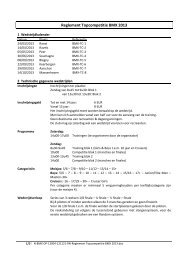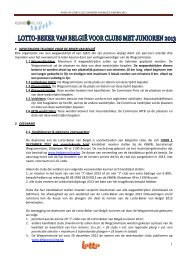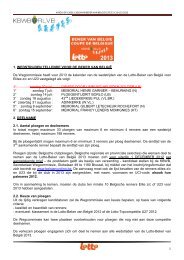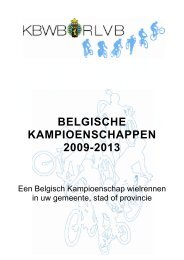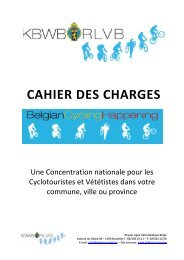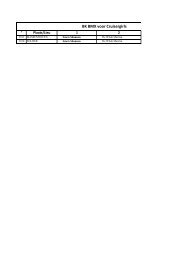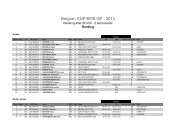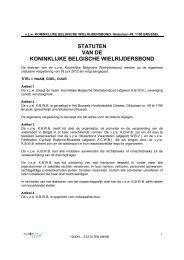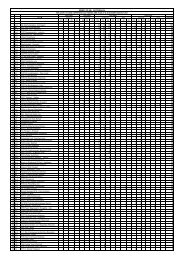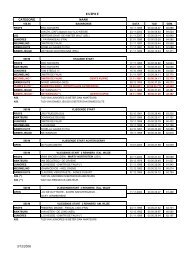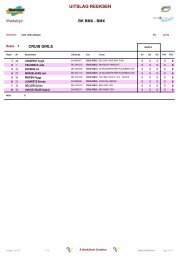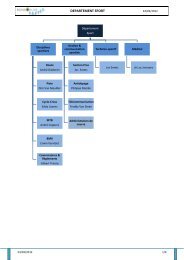Practical guide for organising mountain bike events - UCI
Practical guide for organising mountain bike events - UCI
Practical guide for organising mountain bike events - UCI
You also want an ePaper? Increase the reach of your titles
YUMPU automatically turns print PDFs into web optimized ePapers that Google loves.
<strong>Practical</strong> <strong>guide</strong> <strong>for</strong> <strong>organising</strong> hc | c1 | c2 | c3 <strong>mountain</strong> <strong>bike</strong> <strong>events</strong><strong>Practical</strong> <strong>guide</strong> <strong>for</strong> <strong>organising</strong> hc | c1 | c2 | c3 <strong>mountain</strong> <strong>bike</strong> <strong>events</strong>2• Start and finish zonesThe start banners or arches must be placed immediately above the starting and finish lines at least 2.5 metres abovethe ground and all the way across the circuit.The starting line must be at least 8 metres wide over a minimum distance of 100 metres after the line. It must be laid outin a flat sector or on an upward slope.The first hectometres after the starting line must be obstacle free to allow the bunch to gradually spread out.Barriers made of a hard material are required on both sides of the course approximately 100 metres be<strong>for</strong>e and 50metres after the finish line. The finishing zone must be at least 4 metres wide over a minimum distance of 50 metresbe<strong>for</strong>e the line and 20 metres after it. It should be laid out in a flat sector or on an upward slope.• Feed / Technical assistance zoneProvide a zone which is between 75 and 200 metres long, in a flat sector or on an upward slope, where speed issufficiently low and in a place which is wide enough to allow riders who are not taking refreshments or those whohave already done so to pass by without incident. Technical assistance / refreshments are always taken on theright-hand side.Rules relating to technical assistance:4.2.033 Feeding is permitted only in the zones designated <strong>for</strong> that purpose, which are also used as technicalassistance zones.4.2.039 Physical contact between feeders/mechanics and riders will be permitted only in feed/technical assistancezones. Water bottles and food must be passed up to the rider by hand by the feeder or the mechanic. Thefeeder or mechanic is not permitted to run alongside his rider.4.2.042 No rider may turn back on the course to reach a feeding/technical assistance zone. Any rider doing so willbe disqualified.4.2.043 Technical assistance during a race is permitted subject to the conditions below.4.2.044 Authorised technical assistance during a race consists of repairs to or the replacement of any part of thebicycle other than the frame. Bike changes are not permitted and the rider must cross the finishing line withthe same handlebar number plate that he had at the start.4.2.045 Technical assistance shall only be given in the feed/technical assistance zones.20At least three zones must be judiciously set up on the course.4.2.046 Spare equipment and tools <strong>for</strong> repairs must be kept in these zones. Repairs and equipment changes canbe carried out by the rider himself or with the help of a team-mate, team mechanic or neutral technicalassistance. Small items such as an inner tube or a small tool may be handed up from the feed/technicalassistance zones.214.2.047 In addition to technical assistance in feed zones, technical assistance is permitted outside these zonesonly between riders who are members of the same <strong>UCI</strong> MTB team or of the same national team. Riders maycarry tools and spare parts provided that these do not involve any danger to the rider himself or the othercompetitors.The zones must be clearly identified.• Safety and first aidThe establishment of first aid services must allow assistance to be given to riders and spectators as quickly aspossible, over the whole circuit. Take the necessary steps when allocating marshal positions.Provide each marshal with the map <strong>for</strong> <strong>organising</strong> first aid so that he can pinpoint its location in the event of anaccident.The radio communication system must cover the whole course with no «dead areas». The marshals and the first aidservice must all be in close contact with each other by radio and with the organisers and the Commissaires.Zone logoOrganizerZone logoOrganizer4.2.055 The organiser must take the measures required to facilitate the rapid evacuation of injured persons fromany point of the course. All-terrain vehicles (motorcycles, quads, etc.) and experienced drivers must beavailable to reach difficult areas quickly.Potential hazard areas must be clearly identified and should be accessible by ambulance (four wheel driveif necessary).Examples of signposting:startFeedMarshals working on potentially risky stretches of the circuit must carry a yellow flag which must be waved if there isa spill so as to warn the other riders. In these sectors, marshals should stand in direct view of their nearest colleagues.They signal the arrival of the next rider or riders with a short, shrill whistle.refreshments zoneTECHNical ASSISTANCErefreshments zoneTECHNical ASSISTANCEApproximately 15 or 20 minutes be<strong>for</strong>e the competitors set off, arrange to have the course checked by a motor<strong>bike</strong>rider. Provide safety tape and arrows to make any corrections necessary to ensure the proper conduct of the race.A second motor<strong>bike</strong> must be used to clear the course and to warn the marshals and spectators of the imminent arrivalof the riders. A third motor<strong>bike</strong> must be used to close the race. It must remain at a reasonable distance, i.e. approximately100 metres, behind the last rider so as not to hamper his progress.



